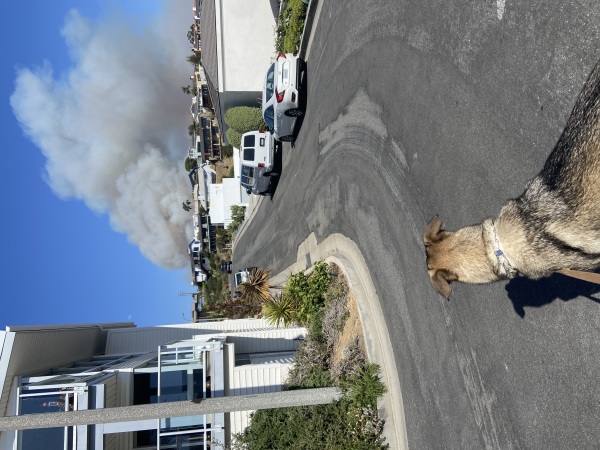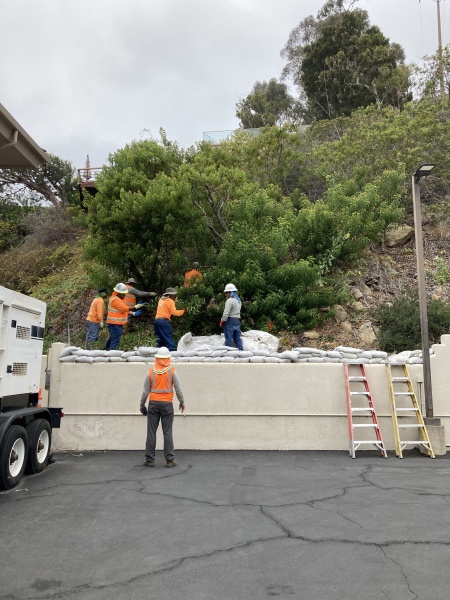By now, we’ve all heard the statistics from the recent Coastal Fire: 20 homes lost, more homes damaged, and 200 acres of native habitat lost. Prior to the start of the fire, it was a beautiful day in Laguna. Cool and breezy winds drifted from our beaches while humidity levels sat around 70%, a decidedly unexceptional weather day. But as smoke began to billow from Aliso Creek, we were all quickly reminded of the now year-round fire threat in California—especially in the beautiful city of Laguna Beach, with its steep hillsides and vast open space. Below, we will discuss the contributing factors for increased risk, the steps residents can take to mitigate risk, and the science & philosophy behind LCF’s fuel modification work with the City.
WHAT’S CONTRIBUTING TO INCREASED FIRE THREAT AND AN EXTENDED FIRE-SEASON?
It comes as no surprise that climate change is one of the leading contributors to increased fire risk. The changing climate creates abnormal weather patterns and overall decreased rainfall in California. Orange County is currently experiencing its third driest year observed in the last 128 years. This added stress on the local habitat has resulted in increased plant death and higher susceptibility to plant disease and pests, greatly increasing dry fuels. Potentially exacerbating the situation, Santa Ana winds may be increasing in frequency and severity, according to recent studies, though these results are not yet definitive.
The impact is a longer fire season with increased fire intensity and less predictable fires. Paired with our vast—beloved—open space and steep canyons, Laguna is uniquely susceptible to fire threat.
WHAT CAN RESIDENTS DO TO HELP MITIGATE FIRE RISK?
The most important step homeowners can take to protect themselves and their neighborhood is to follow the regulations in Chapter 7A of the California Building Code, which details the minimum standards for homes at the urban-wildland interface. These steps include using non-combustible materials for roofs, wall sidings and eaves, attic vents that prevent embers from entering the home, and tempered double-pane windows which insulate heat and have a higher heat tolerance. By retrofitting current homes to these standards, we protect not only ourselves, but our neighbors too.

During the Coastal Fire, 100% of the initial homes that caught fire did so by way of embers. Hardening one’s home is a proven and effective measure in mitigating risk, but homeowners can also look to their landscaping and surrounding vegetation. Native plants, which are uniquely suited to our environment, can enhance landscaped areas with their homegrown beauty—and they are easier to maintain, being water efficient and drought tolerant. They also provide greater protection from fires than many of the non-native plants commonly found in yards and/or encroaching on native habitat. Lemonade Berry (Rhus integrifolia) is a great example of one such native plant—it remains green year-round, stores water, and can act as a screen, protecting homes from airborne embers. Additionally, maintaining discontinuous vegetation helps reduce fire intensity and spread.
Removal of non-native plants—from within landscaped areas—that are known fire hazards is another great step. These plants include species such as Pampas Grass (Cortaderia spp.), Fountain Grass (Pennisetum setaceum), Big Reed (Arundo donax), Pines (Pinus spp.), English/Canary Island Ivy (Hedera spp.) and other species that create dense fuels and/or weedy, fast-burning fuels. While removal of these species in open space should be performed only under the supervision of a biologist, due to sensitive habitat and rare or endangered species, the public is encouraged to reach out either to the Laguna Beach Fire Dept. or Laguna Canyon Foundation with any questions, concerns, and/or comments regarding open space. To contact Laguna Canyon Foundation regarding fuel modification, please contact chris@lagunacanyon.org.
While these steps cannot remove all risk, they provide first responders with the defensible space and extra time to protect people and property.
WHAT IS LCF’s ROLE IN FUEL MODIFICATION?
Here at Laguna Canyon Foundation, it’s no secret that we love our native habitat—and that’s why we were grateful to partner with the Laguna Beach Fire Department and others to develop an effective and environmentally sensitive fuel modification program. The program developed primarily provides defensible space to 100’ from primary structures. Through non-native plant removal, fuel reduction, limbing-up large shrubs and trees, and additional removal based on an ecologically based hierarchy, we reduce vegetation to a discontinuous 50%. Vegetation reduction at this level, according to the best available data, provides an approximate 70% reduction in fire intensity and flame height. Additionally, as mentioned above, the remaining vegetation can act as a screen, protecting homes from embers.
We also help to protect the one-of-a-kind Coastal Sage Scrub and Maritime Chapparal that surrounds us. These beautiful habitat types are considered bio-diversity hotspots and contain many species of plants and animals that are rare, threatened, or endangered—some of which occur almost exclusively in our neck of the woods. As partners in the City’s Fuel Modification Program, it is our role to provide biological oversight to the skilled hand crews completing fuel reduction. Along with the hand crew’s exceptional plant knowledge and skill, we take a role in monitoring progress, directing vegetation removal, coordinating with the Fire Department, communicating and coordinating with neighbors, and conducting rare plant and nesting bird surveys.
A proud moment for us here at LCF came when the Executive Director of the California Coastal Commission, Jack Ainsworth, described our program and protocol as “the most environmentally sensitive fuel modification program [he had] seen in the State,” and we hope you all agree. As an environmental non-profit, we take this role seriously and work hard to ensure both the protection of our neighbors and of this irreplaceable treasure—the open space that surrounds us.
Please check out our previous Fuel Mod blog, too: Fuel Modification with the Fire Department
photos by Lalo Maldonado (Nature’s Image) and Paula Olson (LCF)


